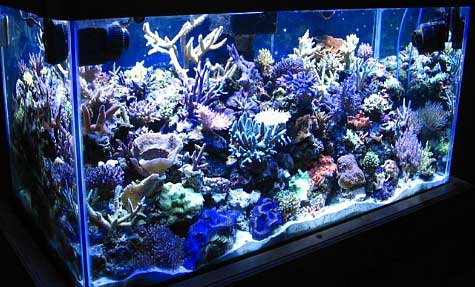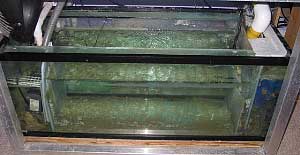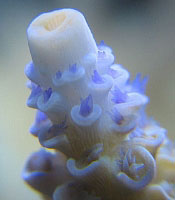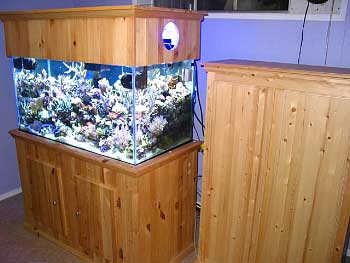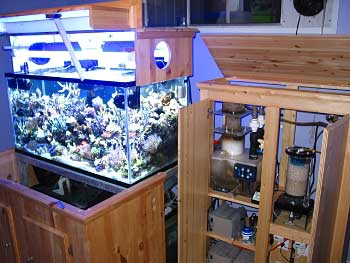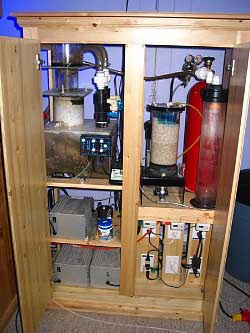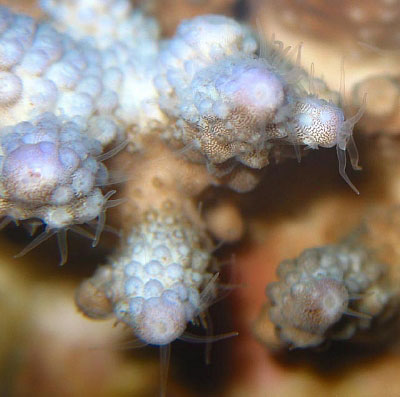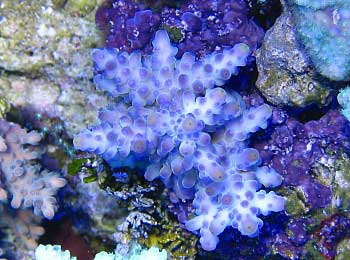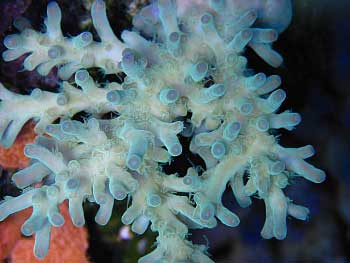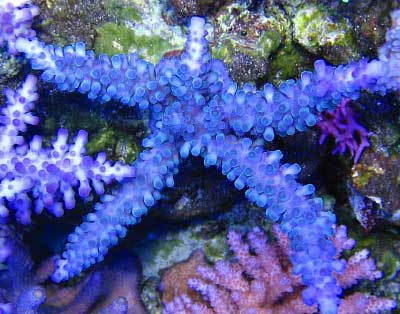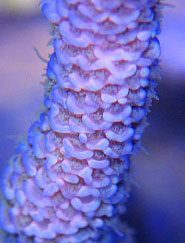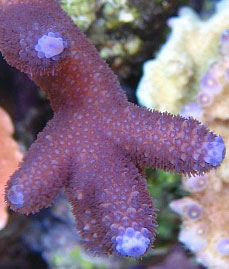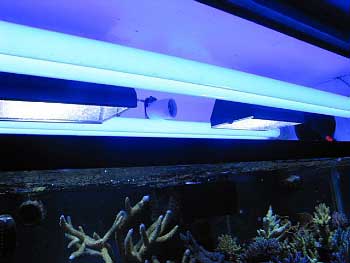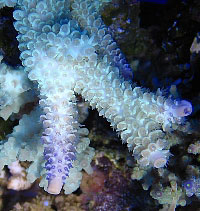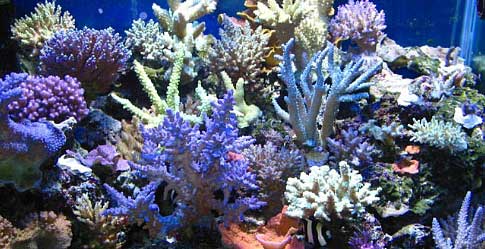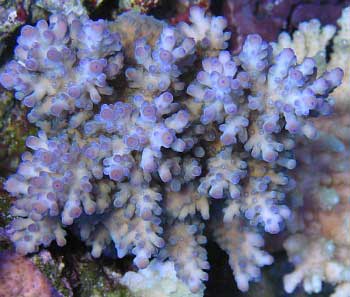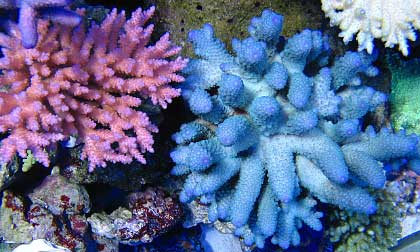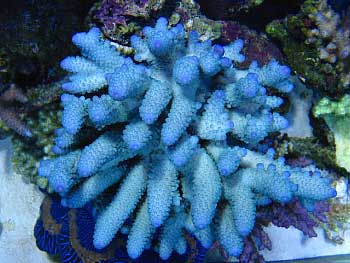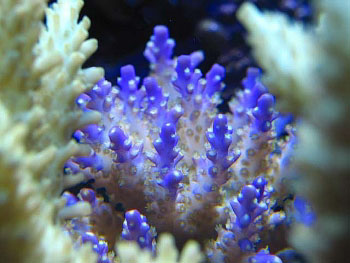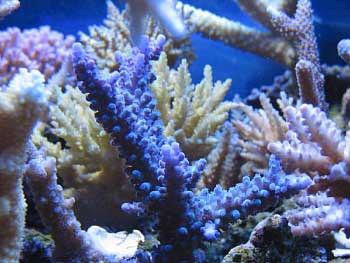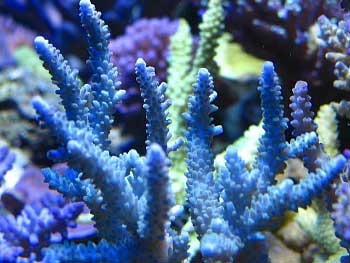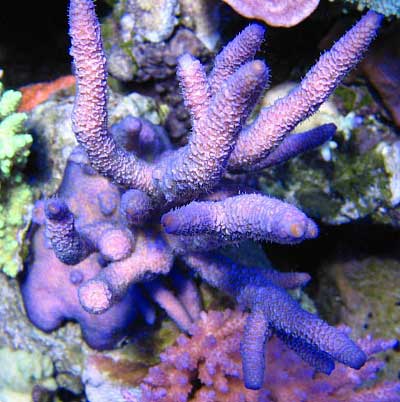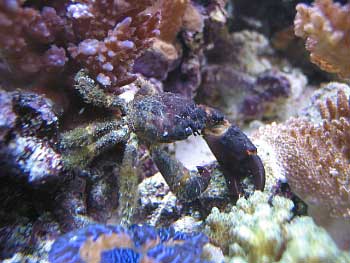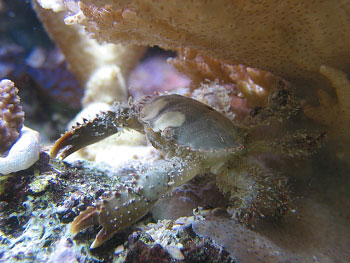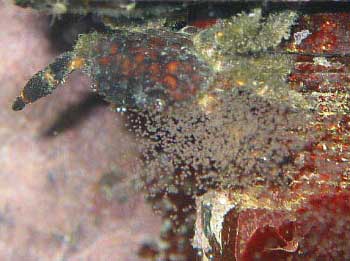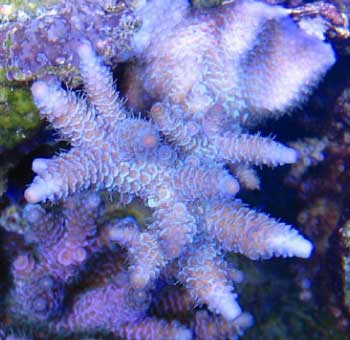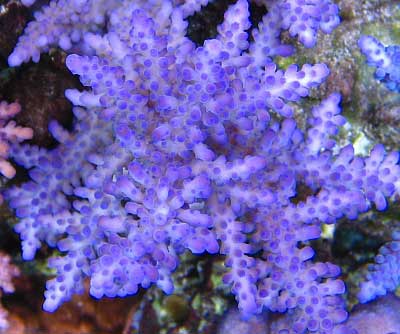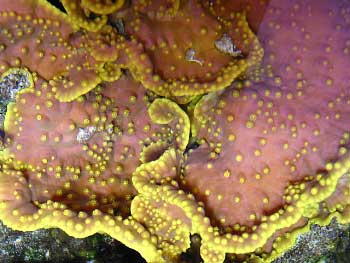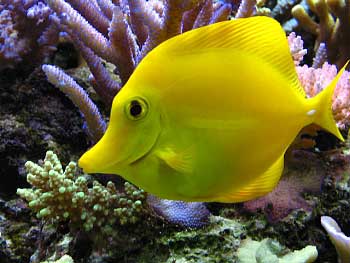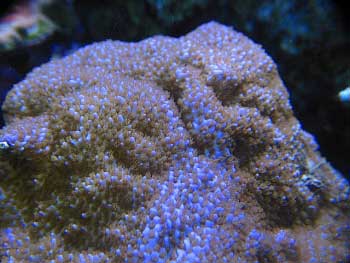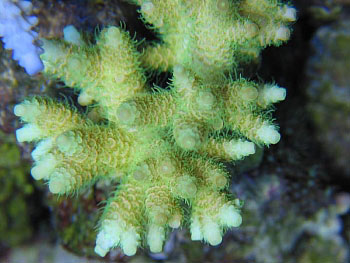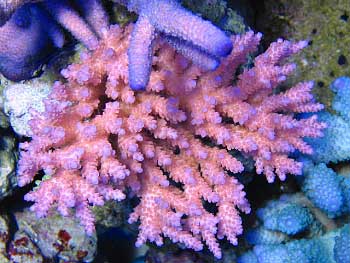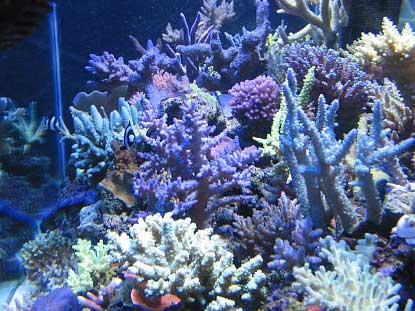
|
|
|
Jamie Cross's (Acro) Reef Aquarium
Introduction Without a doubt the reefkeeping hobby is alive and well in the year 2003. I recall starting out some seven years ago and how difficult it was to learn about, view or find many successful systems. Today, it is a much different story with a huge array of incredible aquariums available to study, ranging from the rhythmic sway of a soft coral display to the popular and colorful stony coral tank. Like most, I started with some soft corals and then progressed to collecting SPS corals. As you can see from the pictures (or just ask my wife), it has become an obsession; an obsession that perhaps has given me more rewards than any other single hobby I've been involved in. Reefkeeping has not only increased my knowledge in aquarium husbandry, but it has also played a large part in learning of many other skills such as scuba diving, photography, carpentry and plumbing. Most importantly, it has given me some great friendships. Without a doubt, it's a fascinating hobby we all share and love. I'd now like to welcome you to read on and learn how I am currently running this system.
System Design The main display has been created within a 120-gallon SeaStar glass aquarium, which I have owned for about five years. Over the years the tank has been moved three times. Just recently, we purchased our first home so the tank has only been set up in it's current location for just over four months which explains why there are so few fish. Unfortunately, through the moving process I lost a few long-term residents of the reef, including a five-year-old Christmas wrasse (Halichoeres ornatissimus) and a two-year-old Regal tang (Paracanthurus hepatus).
The sump is a 70-gallon glass aquarium that I've modified with the use of three baffles to help reduce bubbles being transferred back to the main display. Originally, it was set up to mimic the EcoSystem style refugium/sump, but before moving I decided to remove it and go with a bare sump instead. Equipment located in the sump area includes two 250-watt Ebo-Jager heaters, a grounding probe, a temperature probe and a pH probe. Additionally, a Honeywell fan is directed over the sump to help cool the tank in the warm summer months. A Kent float valve is installed in the sump to regulate the flow of automated freshwater top-off via a ReefPure 100gpd 5-stage RO/DI unit. As an added safety precaution, an inline solenoid valve is installed ahead of the RO/DI unit so that the fresh water input to the sump only remains on for one hour per day. The rationale behind this was in the event that the float valve ever failed or if there was a leak somewhere within the tank, freshwater will only be added for that one hour rather than continuously, thereby reducing the chance of lowering the salinity of the tank to dangerous levels.
The tank itself rests on an aluminum frame, which is surrounded by a pine skirt that was designed to enclose the stand and yet still allow for full access to the sump area. Over the years this has proven to be a great option. The canopy is also made from pine, again with full access to the top of the tank in mind. This was accomplished by designing it so the entire front panel folds up and rests on the remainder of the canopy. A pine equipment closet, with two full sized doors and a hinged top, houses all the system's equipment. All of the cabinetry was designed and manufactured with the help from my good friend, Marc, and my father in-law, Dave. You know what they say, "Thank God for friends and family." Well, I certainly did, as it would not have turned out nearly as well without their help.
Circulation The main return lines for this system exit through two Aquarium Currents 1" Sea Swirls, both of which are plumbed to their own individual pump. The return line on the left rear of the tank receives its water flow via a GenX Mak 4 pump (1190gph @ 0'), while the right rear Sea Swirl is supplied by a Mag 12 pump (1200gph @ 0'). This current alone provides roughly a 16 x turnover rate, assuming both pumps provide 1000gph after allowing for slowdowns caused by the plumbing. In addition to the returns, Tunze's TS24 kit provides over 6000gph when operating at full volume. All of these pumps combined result in a total tank turnover rate of over 66 times per hour. With this much current running throughout the night, I found that the corals don't show any significant nighttime polyp expansion, so I've elected to shut the Tunze's off during the night with the use of a digital timer.
Night time polyp expansion is a great indicator of coral
health.
Filtration
Natural filtration for this system consists of approximately 160lbs. of Fiji live rock. A table constructed with PVC and eggcrate was used to elevate the rock above the substrate. This enabled me to use far less rock as well as increase water movement under the reef structure. A sand bed consisting of between 1- 2" of oolithic aragonite sand may provide a bit of additional natural filtration. Filtration is supplemented with a do-it-yourself dual Beckett skimmer and the injectors are powered by a Gen-X pcx100 pump (1550gph @ O'). Additionally, approximately 1 1/2 cup of Marineland Black Diamond carbon is placed in a high flow area of the sump, and this is replaced weekly.
Lighting To provide illumination over this set-up, I've chosen a combination of fluorescent lights and metal halides. Four 40-watt Phillips 03 actinics are powered by an Icecap 660 ballast. Two PFO single HQI ballasts, powering Aqualine Bushke's double-ended 250 watt 10K bulbs, provide the main lighting. The PFO mini pendants are located only 5" above the water surface. I've been very happy with this lighting arrangement and it's been in operation for close to three years. Prior to this recent move I did run a single 400-watt radium over the center of the tank between the two 250 watt halides. I no longer use the middle light as the tank room in the new house is lacking in available power. Also, I personally didn't see any benefit to the third light other than the aesthetic enhancement it provided.
Water Chemistry
Perhaps the single best purchase for this system was a calcium reactor. Some five years ago I bought an Advanced Reef Technologies K2R reactor. Since that time, I've added a do-it-yourself secondary chamber onto the output of the reactor. Without the introduction of this invaluable piece of equipment, I truly don't know if I would even still be involved in this hobby. Prior to its addition I was adding supplements on a daily basis just to simply maintain bare minimum acceptable calcium and alkalinity levels. Due to this issue of daily manual supplementation, it was not possible for me to leave the house for much longer than overnight. Now, I can leave for days and up to weeks at a time with only the need for someone to stop by and feed the fish and do some general checking up on the system.
Maintenance Without a doubt, maintenance is one of the most important parts of keeping a successful reef. For me, the most enjoyable maintenance performed on this system is the daily inspections on both the corals and fishes health and overall proper functioning of the system. It is my belief that the single most important visual inspection is checking for the coral's nighttime polyp expansion, as I personally feel this is perhaps the best way to judge the system's overall health. Some of the more mundane weekly chores involve cleaning the throat of the skimmer, emptying the auto shut-off skimmate collection cup and replacing the carbon in the sump. Every two to three days I'll run the Mag-Float glass cleaner over the front glass to remove the slight diatom build up. Currently, I'm performing a 20-gallon water change using Instant Ocean salt every two weeks. I've always been a big believer in the need for water changes, and I can honestly say in the past three years I've probably missed less than three planned water changes. Roughly every two to three months I'll either top up or replace the calcium reactor media. Lastly, the bulbs in the canopy are replaced every eight to ten months.
Feeding My typical feeding regime consists of feeding the fish once per day with frozen Mysis, Formula One, or enriched brine shrimp. On occasion, I'll feed Formula One flake food or some nori. Lately, I've been experimenting with feeding the corals freshly hatched brine shrimp. Once per week at around 3:00am I'll feed them to the tank. I've seen the polyps capture the shrimp and believe this is a decent size for most SPS corals to feed on.
Livestock I'd love to explain all the different species of SPS corals I've collected and have in my home aquarium, but I simply don't think I can. So, I'll elect to pass on the naming of each particular species. Instead, I'll let a few of the pictures within this article show you some of the interesting pieces I've collected. I will say, however, that within this system are around six different genera of SPS corals and over 70 different variations that are possibly different species. I only have one LPS coral in the tank, which to my understanding is a branching Heliofungia actiniformis that produces free-living long tentacle plate corals. I've had this coral for well over five years, and it was introduced as a hitchhiker on one of the pieces of live rock. Also, two T. maxima clams have called this system home for over six years. I've seen the larger of the two spawn once and both clams released gametes only a few hours after the most recent move.
As I mentioned earlier, the system is lacking in much of a fish load. Currently, it is home to a 5-year-old yellow tang (Zebrasoma flavescens) and two four-striped damsels, as well as four different species of gobies which live within the coral heads.
Final Thoughts I would now like to take this time to thank all the folks at Reefkeeping Magazine, not only for allowing me to share my aquarium within the e-pages of this great publication, but also for giving us a great bulletin board at Reef Central.com. Without a doubt this hobby would not be as advanced as it is today without these great learning and information sharing tools. With that said, I hope all the readers enjoyed the article and pictures of my reef aquarium.
An unidentified crab perched on the overflow releasing larvae
into the water column.
Feel free to comment or ask questions about my tank in the forum for the online magazine. [Editor's
note: Jamie's tank was featured in Mike Palleta's new
book, Ultimate
Marine Aquariums: Saltwater Dream Systems and How They Are
Created.]
|


